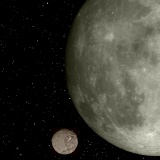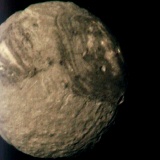 |
|
|
Computer-generated
view across Inverness Corona.
|
|
| MIRANDA - MOON OF URANUS | |
| Miranda is named after the daughter of Prospero, the magician in Shakespeare's play "The Tempest". Since Miranda's discovery by Gerard Kuiper in 1948 very little attention was paid to the moon. Before the Voyager flyby it was expected that Miranda would be of little interest. Its low temperature (-187oC), and small size, suggested that it would be a simple ball of ice and rock with perhaps a few craters. The reality has turned out somewhat different. | |
| Orbit | |
| Miranda is the innermost of Uranus's larger moons orbiting at a distance of 130,000 kilometres. It is in a synchronous orbit, always presenting the same face towards Uranus. It takes 1.4 days to make one orbit of Uranus and a complete rotation on its axis. | |
 The orbits of Uranus' larger moons. |
|
| Physical properties | |
| Miranda is just 470 kilometres in diameter and has a very low density, 1350 kg m-3 . Miranda is the least massive, and the smallest, of Uranus' five large moons. It is these properties that led scientists to believe the Voyager encounter with Miranda would be uninteresting. | |
 Comparison between Miranda and Earth's moon. |
|
| Atmosphere | |
| No atmosphere has been detected. | |
| Magnetic field | |
| Voyager failed to detect a magnetic field at Miranda. | |
| Interior | |
| From the low density, it is inferred that Miranda comprises as much as 50% water ice. There is probably a little frozen methane as well. | |
| Miranda, at first glance, appears to have had a very disturbed history. One theory was that Miranda had at some time in its past been shattered by an impact, and gravity had then welded the moon back together. This would obviously give Miranda a most unusual interior structure - indeed, it would have its "interior" on its surface. However, this theory doesn't fit with well with observation, and there are better mechanisms available to explain the tortured surface. | |
| More about Miranda's interior and evolution | |
| Surface | |
| The pictures of Miranda's surface returned by the Voyager 2 spacecraft were the highest resolution images obtained during the mission. Features just 500 metres across can be seen. This was for two reasons. Because Uranus is so far from the Sun, and poorly illuminated, long exposures were required. Voyager was rotated whilst the image was being recorded to avoid motion blur. Voyager also passed very close to Miranda. This was primarily to get a gravitational boost from Uranus so it could rendezvous with its next target, Neptune. | |
| Voyager passed through the Uranian system at a right angle to the plane in which the moons orbit - this meant that only Miranda was observed at close range. The Voyager mission has shown Miranda to have one of the most baffling geological surfaces in the Solar System. How it arrived at its present state is still not known. | |
 Voyager colour image of Miranda. |
|
| More about Miranda's surface | |
|
|
|